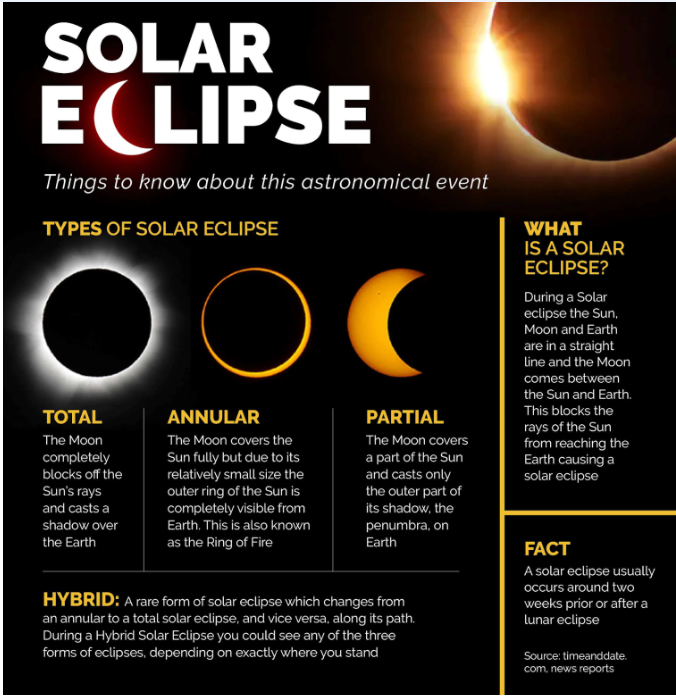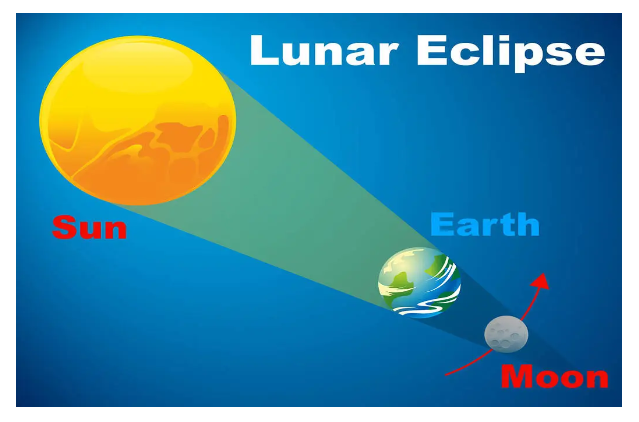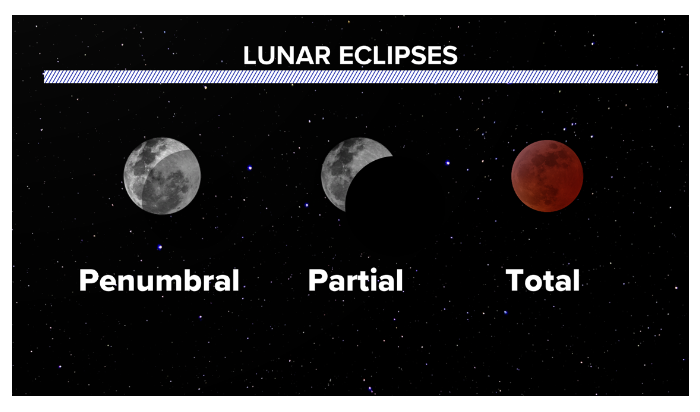Origin-and-evolution-of-universe-solar-system-and-earth / Origin and Evolution of Universe Solar System and Earth / Eclipses – Solar, Lunar
Eclipses are interesting and commonly occurring astronomical events. They come in various types and have different sub-categories. In this discussion, we will explore the details of eclipses. The term "eclipse" finds its origin in ancient Greek, where it means "abandonment" or "darkening of a heavenly body."
SOLAR ECLIPSE
A solar eclipse occurs when the Moon passes between the Sun and Earth, causing the Sun's light to be fully or partially blocked in certain areas on Earth. There are different types of solar eclipses:

Total Solar Eclipse:
- During a total solar eclipse, the New Moon comes between the Sun and Earth and casts the darkest part of its shadow, called the umbra, on Earth.
- This results in a complete covering of the Sun's disk, and the sky becomes as dark as night.
- At the maximum point of the eclipse (midpoint of totality), the sky darkens, and temperatures can drop.
- Only the Sun's corona, its outer atmosphere, is visible during a total solar eclipse.
Annular Solar Eclipse:
- An annular solar eclipse occurs when the Moon is at or near its farthest point from Earth while passing between the Sun and Earth.
- Because of the greater distance, the Moon appears smaller and does not completely cover the Sun.
- This creates a ring-like appearance, where the dark disk of the Moon is surrounded by the bright ring of the Sun.
Partial Solar Eclipse:
- A partial solar eclipse takes place when the Sun, Moon, and Earth are not perfectly aligned. In this scenario, only a portion of the Sun's surface appears to be covered by the Moon, resulting in a crescent shape.
- People outside the Moon's inner shadow area during a total or annular eclipse observe a partial solar eclipse.
Hybrid Solar Eclipse:
- The Earth's curved surface can lead to a shifting eclipse type as the Moon's shadow moves across the planet. This unique situation is referred to as a hybrid solar eclipse.
- It may transition between annular and total eclipses as it progresses across different regions.
- These various solar eclipse types create captivating astronomical events that capture the attention of people around the world.

LUNAR ECLIPSE
A lunar eclipse occurs when the Moon moves into the Earth's shadow. For a lunar eclipse to happen, the Earth must be positioned directly between the Sun and the Moon, and this celestial event can only take place during a full Moon.

Here's how a lunar eclipse unfolds:
- Penumbral Phase:
- The Moon first moves into the Earth's penumbra, which is the outer part of the Earth's shadow. During this phase, not all of the Sun's light is completely blocked out. As a result, a portion of the Moon's surface appears dimmer than during a typical full Moon.
- Umbral Phase
- Subsequently, the Moon progresses into the Earth's umbra, which is the inner and darker part of the Earth's shadow. In this phase, direct sunlight from the Sun is entirely blocked by the Earth, causing the only light illuminating the Moon's surface to be light that has been refracted, or bent, by passing through the Earth's atmosphere.
- Total Lunar Eclipse
- It occurs when the Earth positions itself between the Sun and the Moon, causing its shadow to be cast upon the lunar surface. During this event, the entire lunar disk enters the Earth's umbra, leading to a reddish appearance of the Moon, often referred to as a "Blood Moon."
- The Moon appears red during a Total Lunar Eclipse due to a phenomenon known as Rayleigh scattering.
- Rayleigh scattering is the scattering of light by particles in a medium without any change in its wavelength. This is the same reason why our sky appears blue. The Moon takes on this reddish hue because the only sunlight reaching it has passed through the Earth's atmosphere. During this passage, the sunlight scatters as it interacts with dust or clouds in our atmosphere, producing the red coloration.
- Total lunar eclipses occur approximately once every year and a half, according to NASA (National Aeronautics and Space Administration).
- Partial Lunar Eclipse
- It happens when there is an imperfect alignment of the Sun, Earth, and Moon. In this case, the Moon only partially enters the Earth's umbra, and the shadow doesn't completely cover the entire lunar surface. The shadow grows and then retreats without fully obscuring the Moon.
- Penumbral Eclipse
- It involves the Moon passing through the Earth's penumbra, which is the faint, outer part of the Earth's shadow. This results in only a subtle dimming of the Moon, often challenging to notice compared to the more dramatic total or partial lunar eclipse.


